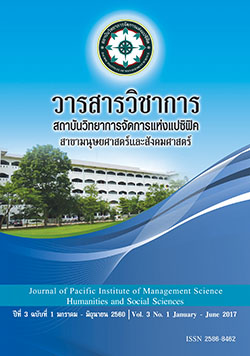An Analysis of the Relationship of Knowledge Management in the Factors Contributing to the Success of Community Enterprise Management
Keywords:
Knowledge management, Community enterprise management, factors contributing to a successful.Abstract
This research aims to investigate into knowledge management and factors contributing to a successful community enterprise’s management. Quantitative research method was employed. Data were collected through questionnaires which were distributed to the study samples an excellent community enterprise which was honored with the first rank reward from 2012 – 2015 along with other designated 169 community enterprises. Such sample size was determined by using Krejcie and Morgan approach of which result show reliability value at 0.05. Data were analyzed using descriptive statistics while hypothesis of the study was tested through correlation analysis using Pearson Correlation Coefficient.
Findings show that knowledge management is correlated to successful community enterprise management with significant value at 0.01 (P = .000, r = .759). When looking into details of such correlation, it was found that all six steps concerning knowledge management is predominantly related to factors regarding knowledge or wisdom followed by two different correlations which are ‘personnel correlating to knowledge identification and knowledge distribution’ and ‘brand image correlating to knowledge auditing and monitoring’. In light of factors regarding information technology and communications, it was found that such is correlated to the knowledge creation and acquisition, knowledge storage, and knowledge utilization. The least significant types of correlation are ‘knowledge management in knowledge creation and acquisition’ and ‘knowledge auditing and monitoring’ which least affected organization/ community’s culture as well as knowledge distribution and knowledge utilization which also pose least influence to leadership with the enterprises. Another less significant type of correlation is between knowledge identification and knowledge storage and brand image.
The results denote the importance of the study on correlation between knowledge management and factors contributing to the success of community enterprises—one of the enterprises is an enterprise which was presented with honorable reward as excellent example. Therefore, if more community enterprises are being supported to adopt and use knowledge management which can lead to success, development will certainly be brought into those enterprises in Thailand.
References
เต็มดวง ตรธีญัญพงษ์ และคณะ.(2546). สรุปผลงานวิจัยธุรกิจชุมชน 58 โครงการ. กรุงเทพฯ : โรงพิมพค์รุสุภาลาดพร้าว.
ธงชัย พาบุ. (2552). การจัดการความรู้ธุรกิจสุดยอดหนึ่งตำบลหนึ่งผลิตภัณฑ์ . วิทยานิพันธุ์ปริญญาปรัชญาดุษฎีบัณฑิต สาขาวิชาสารสนเทศึกษา บัณฑิตวิทยาลัย มหาวิทยาลัยขอนแก่น.
ธงชัย พาบุ, กุลธิดา ท้วมสุข และชลภัสส์ วงษ์ประเสริฐ. (2553). การจัดการความรู้ของธุรกิจสุดยอดหนึ่งตำบลหนึ่ง ผลิตภัณฑ์กลุ่มอาชีพทอผ้าไหมมดัหมี่ ศูนย์ห์ตัถกรรมพื้นบ้านอำเภอนาโพธิ์ วารสารวิจัยสมาคมห้องสมุดฯ 3(1): 52-67.
ธานินทร์ ศิลป์จารุ. (2551). การวิจัยและการวิเคราะห์ข้อมูลทางสถิติด้วย SPSS. กรุงเทพฯ : วีอินเตอร์พรินท์ .
บุญชม ศรีสะอาด. (2553).การวิจัยเบื้องต้น. กรุงเทพฯ : สุวีริยาสาส์น.
ภัทรธิรา ผลงาม. (2545).รายงานการวิจัยเรื่องการพัฒนาธุรกิจชุมชนแบบมีส่วนร่วม : การผลิตไวน์ข้าวเหนียว (ดำ).
เลย : สถาบันราชภัฎเลย.
เมธา สุธีรโรจน์ . (2547). ผลการวิจัยเรื่องปัจจัยที่มีผลต่อความสำเร็จของธุรกิจชุมชนในภาคตะวันออกเฉียงเหนือ. ว. วิจัยและฝึกอบรม สถาบันเทคโนโลยีราชมงคล วิทยาเขตภาคตะวันออกเฉียงเหนือ, 2(1), 2-15.
สำนักงานเลขานุการคณะกรรมการส่งเสริมวิสาหกิจชุมชน. (2555). วิสาหกิจชุมชนดีเด่นปี 2555. กรุงเทพฯ : โรงพิมพ์ ชุมนุมสหกรณ์การเกษตร.
สำนักงานเลขานุการคณะกรรมการส่งเสริมวิสาหกิจชุมชน. (2556). วิสาหกิจชุมชนดีเด่นปี 2556. กรุงเทพฯ : โรงพิมพ์ ชุมนุมสหกรณ์การเกษตร.
สำนักงานเลขานุการคณะกรรมการส่งเสริมวิสาหกิจชุมชน. (2557). วิสาหกิจชุมชนดีเด่นปี 2557. กรุงเทพฯ : โรงพิมพ์ ชุมนุมสหกรณ์การเกษตร.
สำนักงานเลขานุการคณะกรรมการส่งเสริมวิสาหกิจชุมชน. (2558). วิสาหกิจชุมชนดีเด่นปี 2558. กรุงเทพฯ : โรงพิมพ์ ชุมนุมสหกรณ์การเกษตร.
สำราญ มีแจ้ง. (2557). สถิติขั้นสูงสำหรับการวิจัย : ทฤษฎีและปฏิบัติ.กรุงเทพฯ : โรงพิมพ์แห่งจุฬาลงกรณ์มหาวิทยาลัย.
Marquardt, M.J. (1996). Building the learning Organization. New York: McGraw Hill.
Nonaka, I. and Takeuchi, H. (1995). The Knowledge Creating Company. New York: OxfordUniversity Press.
O่ Dell, C. and Grayson, C.J., Jr. (1998). If Only We Knew What We Know: The Transfer ofInternal Knowledge and Best Practice.New York: Free Press.
Probst, G., Raub, S. and Romhardt, K. (2000). Managing Knowledge: Building Blocks forSuccess. Chichester: John Wiley and Sons.
Sveiby, K..E. (1997). The New Organizational Wealth: Managing and Measuring Knowledge Based Assets. San Francisco, CA :Berrett-Koehler..
Tuamsuk, K., Phabu, T, &Vongprasert, C. (2013). Knowledge management model of community business: Thai OTOP Champions. Journal of Knowledge Management 17(3): 363-378.
Turban, E. et al. (2004). Information Technology for Management: TransformingOrganizations in the Digital Economy. 4thed. New Jersey: John Wiley & Sons.
Wiig, K.M. (1993). Knowledge Management Foundation.Texas: Schema Press
Downloads
Published
Issue
Section
License
บทความที่ได้รับการตีพิมพ์เป็นลิขสิทธิ์ของ สถาบันวิทยาการจัดการแห่งแปซิฟิค
ข้อความที่ปรากฏในบทความแต่ละเรื่องในวารสารวิชาการเล่มนี้เป็นความคิดเห็นส่วนตัวของผู้เขียนแต่ละท่านไม่เกี่ยวข้องกับสถาบันวิทยาการจัดการแห่งแปซิฟิค และคณาจารย์ท่านอื่นๆในสถาบันฯ แต่อย่างใด ความรับผิดชอบองค์ประกอบทั้งหมดของบทความแต่ละเรื่องเป็นของผู้เขียนแต่ละท่าน หากมีความผิดพลาดใดๆ ผู้เขียนแต่ละท่านจะรับผิดชอบบทความของตนเองแต่ผู้เดียว







